Advantages of High-Temporal L-Band SAR Observations for Estimating Active Landslide Dynamics: A Case Study of the Kounai Landslide in Sobetsu Town, Hokkaido, Japan
Abstract
:1. Introduction
2. Overview of Kounai-1 and Kounai-2
3. Methods
3.1. Creating Interferograms
3.2. Accuracy Validation of Interferograms
- (1)
- GNSS positioning (Figure 5a): We converted the ground movements observed by GNSS positioning during the same time window as the interferograms (Figure 1c) into the LoS direction based on [54] (pp. 162–163). For an incidence angle of ALOS-2 ≈ 32.5° and heading from the north of ALOS-2 (i.e., Azimuth direction) ≈ 190.5°. The locations of GNSS positioning are shown in Figure 1b. Subsequently, we calculated the residual Root Mean Square (RMS) of the GNSS-derived and DInSAR-derived LoS displacements.
- (2)
- Airborne LiDAR survey (Figure 5b): Airborne LiDAR can measure elevation (e.g., see [55,56,57]). We investigated whether the areas where LoS displacement was observed in the interferograms corresponded to areas with elevation changes identified in the airborne LiDAR survey. We utilized a 1 m grid DEM generated by airborne LiDAR surveys on 10 October 2013 and 27 November 2023. The survey was planned for 10 October 2013 for the Hokkaido Regional Development Bureau and operated by the Hokkai Aerosurvey Corporation. The second project was planned and operated by the Hokkaido Research Organization. Unmanned Aerial Vehicle (UAV)-based LiDAR mapping was performed on 27 November 2023, using real-time kinematic (RTK) GNSS with a reference point. The point-cloud density during DEM creation was 4 points/m2.
- (3)
- Field survey (Figure 5c): Field surveys conducted between 2022 and 2023 confirmed ground movements. We verified whether the ground movements observed during the field survey matched the LoS displacements obtained from the interferograms.
4. Results
4.1. Comparison of Interferograms and Landslide Topography
4.2. Comparison of Interferograms and GNSS Positioning
4.3. Comparison of Interferograms and Airborne LiDAR Survey
4.4. Comparison of Interferograms and Field Survey
- Near the western extension of the main cliff of Kounai-2, within the area between Kounai-1 and Kounai-2, an aerial LiDAR survey observed subsidence from about 70 to 370 cm (“F” in Figure 11). Cliffs of approximately 5 m were formed (Figure 13f), and at the location where this cliff climbed, a fresh small cliff of approximately 35 cm was formed (Figure 13f).
5. Discussion
5.1. Advantage of High-Temporal L-Band SAR Observations in Estimating Landslide Dynamics
5.2. Dynamics of Kounai-1 and Kounai-2
6. Conclusions
Author Contributions
Funding
Data Availability Statement
Acknowledgments
Conflicts of Interest
References
- Varnes, D.J. Slope movement types and process. In Landslides, Analysis and Control; Schuster, R.L., Krizek, R.J., Eds.; Special Report 176; Transportation Research Board, National Academy of Sciences: Washington, DC, USA, 1978; pp. 11–33. [Google Scholar]
- Ren, S.; Zhang, Y.; Li, J.; Zhou, Z.; Liu, X.; Tao, C. Deformation Behavior and Reactivation Mechanism of the Dandu Ancient Landslide Triggered by Seasonal Rainfall: A Case Study from the East Tibetan Plateau, China. Remote Sens. 2023, 15, 5538. [Google Scholar] [CrossRef]
- Delbridge, B.G.; Burgmann, R.; Fielding, E.; Hensley, S.; Schulz, W.H. Three-dimensional surface deformation derived from airborne interferometric UAVSAR: Application to the Slumgullion Landslide. J. Geophys. Res. Solid Earth 2016, 121, 3951–3977. [Google Scholar] [CrossRef]
- Raja, N.B.; Çiçek, I.; Türkoğlu, N.; Aydin, A.; Kawasaki, A. Landslide susceptibility mapping of the Sera River Basin using logistic regression model. Nat. Hazards 2017, 85, 1323–1346. [Google Scholar] [CrossRef]
- Sato, H.P.; Une, H. Detection of the 2015 Gorkha earthquake-induced landslide surface deformation in Kathmandu using InSAR images from PALSAR-2 data. Earth Planets Space 2015, 68, 47. [Google Scholar] [CrossRef]
- Dini, B.; Manconi, A.; Loew, S.; Chophel, J. The Punatsangchhu-I dam landslide illuminated by InSAR multitemporal analysis. Sci. Rep. 2020, 10, 8304. [Google Scholar] [CrossRef] [PubMed]
- Masumoto, M.; Nonomura, A.; Hasegawa, S.; Fujisawa, K.; Yamanokuchi, T.; Tadono, T. Estimation of slope deformation by heavy rain in July 2018 using interferometric SAR in Kagawa Pref., Japan. J. Remote Sens. Soc. Jpn. 2020, 40, 97–102, (In Japanese with English abstract). [Google Scholar] [CrossRef]
- Yamagishi, H. Landslides in Hokkaido; Hokkaido University Press: Sapporo, Japan, 1993. (In Japanese) [Google Scholar]
- Ozawa, S.; Ishimaru, S. Web-GIS based information offer of the landslide distribution data-map of Hokkaido. Rep. Geol. Surv. Hokkaido 2011, 83, 73–76. (In Japanese) [Google Scholar]
- Oyagi, N.; Uchiyama, S.; Ogura, M. Landslide Maps, Series 60 the central part of Kanto region explanations of landslides distribution maps. Tech. Note Natl. Res. Inst. Earth Sci. Disa. Prev. 2015, 394, 1–14. Available online: https://dil-opac.bosai.go.jp/publication/nied_tech_note/landslidemap/shared/docs/document.pdf (accessed on 6 April 2024). (In Japanese).
- Yagi, H. Toward practical utilization of landslide inventory map issued by NIED. In Proceedings of the Workshop on the Prediction of Landslide Disasters, Tsukuba, Japan, 3 December 2020; Yamada, R., Iida, T., Eds.; National Research Institute for Earth Science and Disaster Prevention: Ibaraki, Japan, 2021; Technical Note National Research Institute for Earth Science and Disaster Prevention 463; pp. 11–12. Available online: https://nied-repo.bousai.go.jp/records/6480 (accessed on 6 April 2024). (In Japanese)
- Inabe, R.; Furuta, R.; Shimizu, Y.; Inanaga, A.; Suetani, T.; Iyadomi, R. A case study of ALOS-2 emergency disaster prevention for slope failure in Sakae-mura, Simominoshi-gun, Nagano Prefecture, Japan. J. Remote Sens. Soc. Jpn. 2022, 42, 322–326. (In Japanese) [Google Scholar] [CrossRef]
- Takada, Y.; Motono, G. Spatiotemporal behavior of large-scale landslide at Mt. Onnebetsu-dake, Japan, detected by three L-band SAR satellites. Earth Planets Space 2020, 72, 131. [Google Scholar] [CrossRef]
- Liu, J.; Hu, J.; Li, Z.; Ma, Z.; Shi, J.; Xu, W.; Sun, Q. Three-Dimensional Surface Displacements of the 8 January 2022 Mw6.7 Menyuan Earthquake, China from Sentinel-1 and ALOS-2 SAR Observations. Remote Sens. 2022, 14, 1404. [Google Scholar] [CrossRef]
- Yang, Y.-H.; Xu, Q.; Hu, J.-C.; Wang, Y.-S.; Dong, X.-J.; Chen, Q.; Zhang, Y.-J.; Li, H.-L. Source Model and Triggered Aseismic Faulting of the 2021 Mw 7.3 Maduo Earthquake Revealed by the UAV-Lidar/Photogrammetry, InSAR, and Field Investigation. Remote Sens. 2022, 14, 5859. [Google Scholar] [CrossRef]
- Gao, H.; Liao, M.; Liu, X.; Xu, W.; Fang, N. Source Geometry and Causes of the 2019 Ms6.0 Changning Earthquake in Sichuan, China Based on InSAR. Remote Sens. 2022, 14, 2082. [Google Scholar] [CrossRef]
- Doke, R.; Kikugawa, G.; Itadera, K. Very Local Subsidence Near the Hot Spring Region in Hakone Volcano, Japan, Inferred from InSAR Time Series Analysis of ALOS/PALSAR Data. Remote Sens. 2020, 12, 2842. [Google Scholar] [CrossRef]
- Schaefer, L.N.; Lu, Z.; Oommen, T. Post-Eruption Deformation Processes Measured Using ALOS-1 and UAVSAR InSAR at Pacaya Volcano, Guatemala. Remote Sens. 2016, 8, 73. [Google Scholar] [CrossRef]
- Himematsu, Y.; Ozawa, T. Ground deformations associated with an overpressurized hydrothermal systems at Azuma volcano (Japan) revealed by InSAR data. Earth Planets Space 2024, 76, 41. [Google Scholar] [CrossRef]
- Aimaiti, Y.; Yamazaki, F.; Liu, W. Multi-Sensor InSAR Analysis of Progressive Land Subsidence over the Coastal City of Urayasu, Japan. Remote Sens. 2018, 10, 1304. [Google Scholar] [CrossRef]
- Iwahana, G.; Uchida, M.; Liu, L.; Gong, W.; Meyer, F.J.; Guritz, R.; Yamanokuchi, T.; Hinzman, L. InSAR Detection and Field Evidence for Thermokarst after a Tundra Wildfire, Using ALOS-PALSAR. Remote Sens. 2016, 8, 218. [Google Scholar] [CrossRef]
- Morishita, Y.; Lazecky, M.; Wright, T.J.; Weiss, J.R.; Elliott, J.R.; Hooper, A. LiCSBAS: An Open-Source InSAR Time Series Analysis Package Integrated with the LiCSAR Automated Sentinel-1 InSAR Processor. Remote Sens. 2020, 12, 424. [Google Scholar] [CrossRef]
- Wang, Z.; Xu, J.; Shi, X.; Wang, J.; Zhang, W.; Zhang, B. Landslide Inventory in the Downstream of the Niulanjiang River with ALOS PALSAR and Sentinel-1 Datasets. Remote Sens. 2022, 14, 2873. [Google Scholar] [CrossRef]
- Teshebaeva, K.; Roessner, S.; Echtler, H.; Motagh, M.; Wetzel, H.-U.; Molodbekov, B. ALOS/PALSAR InSAR Time-Series Analysis for Detecting Very Slow-Moving Landslides in Southern Kyrgyzstan. Remote Sens. 2015, 7, 8973–8994. [Google Scholar] [CrossRef]
- Ozawa, T.; Nohmi, H. Effect of vegetation on surface deformation measurement using InSAR investigated from laboratory experiments. J. Geod. Soc. Jpn. 2018, 64, 81–88, (In Japanese with English abstract). [Google Scholar] [CrossRef]
- Wei, M.; Sandwell, D.T. Decorrelation of L-band and C-band interferometry over vegetated areas in California. IEEE Trans. Geosci. Remote Sens. 2010, 48, 2942–2952. [Google Scholar] [CrossRef]
- Aoki, Y.; Furuya, M.; De Zan, F.; Doin, M.P.; Eineder, M.; Ohki, M.; Wright, T.J. L-band Synthetic aperture radar: Current and future applications to earth science. Earth Planets Space 2021, 73, 56. [Google Scholar] [CrossRef]
- Nishiguchi, T.; Tsuchiya, S.; Imaizumi, F. Detection and accuracy of landslide movement by InSAR analysis using PALSAR-2 data. Landslides 2017, 14, 1483–1490. [Google Scholar] [CrossRef]
- Japan Aerospace Exploration Agency. About Advanced Land Observing Satellite-4 ‘DAICHI-4’ (ALOS-4). Available online: https://global.jaxa.jp/projects/sat/alos4/ (accessed on 6 April 2024).
- The National Aeronautics and Space Administration. NISAR NASA-ISRO SAR MISSION. Available online: https://nisar.jpl.nasa.gov/ (accessed on 6 April 2024).
- European Space Agency. ROSE-L. Available online: https://sentinel.esa.int/web/sentinel/copernicus/rose-l (accessed on 6 April 2024).
- Morishita, Y.; Sugimoto, R.; Nakamura, R.; Tsutsumi, C.; Natsuaki, R.; Shimada, M. Nationwide urban ground deformation in Japan for 15 years detected by ALOS and Sentinel-1. Pro. Ear. Plan. Sci. 2023, 10, 66. [Google Scholar] [CrossRef]
- Tajika, J.; Ishimaru, S.; Kawakami, G.; Takahashi, R. Geology, landform and recent activity of the large-scale landslides in the middle basin of the Osarugawa river, Hokkaido. Rep. Geol. Surv. Hokkaido 2017, 89, 13–32. Available online: https://opac.std.cloud.iliswave.jp/iwjs0007opc/TC11110849 (accessed on 6 April 2024). (In Japanese).
- Usami, S. Creation and accuracy validation of a Hokkaido Active Landslide Data Map based on TS-InSAR images released by the Geospatial Authority of Japan. E-J. GEO 2024, 19, 132–144, (In Japanese with English abstract). [Google Scholar] [CrossRef]
- Tsunoda, F.; Agui, K.; Kurahashi, T. Analysis of landslide displacement under snow layer using interferometric SAR. In Geotechnical Engineering Magazine; Ishikawa, T., Noda, T., Eds.; The Japanese Geotechnical Society: Tokyo, Japan, 2018; Volume 66, pp. 30–31. Available online: https://thesis.ceri.go.jp/db/documents/public_detail/62664 (accessed on 6 April 2024). (In Japanese)
- Ota, R. 1:50,000 Geological Map of Japan, Tokushunbetsu with Explanatory Text; Geological Survey of Japan: Ibaraki, Japan, 1954; (In Japanese with English abstract); Available online: https://www.gsj.jp/Map/JP/geology4-4.html#04051 (accessed on 26 February 2024).
- Ota, R. 1:50,000 Geological Map of Japan, Abuta with Explanatory Text; Geological Survey of Japan: Ibaraki, Japan, 1956; (In Japanese with English abstract); Available online: https://www.gsj.jp/Map/JP/geology4-4.html#04051 (accessed on 26 February 2024).
- Geospatial Information Authority of Japan. Available online: https://www.gsi.go.jp/LAW/heimencho.html (accessed on 6 April 2024). (In Japanese)
- Wada, N.; Yahata, M.; Ohshima, H.; Yokoyama, E.; Suzuki, T. Geology and Geothermal Resources of West Iburi District, Hokkaido, Japan; Special Report 19; Geological Survey of Hokkaido: Sapporo, Hokkaido, 1988; (In Japanese with English abstract). [Google Scholar]
- Inokuchi, T. Landslide topography of the Sumikawa landslide. J. Jpn. Landslide Soc. 1998, 35, 11–19, (In Japanese with English abstract). [Google Scholar] [CrossRef]
- Matsuura, S.; Kawasaki, K.; Niimi, Y.; Asano, S.; Uchiyama, M.; Okamoto, T. A case study of investigation and mitigation measures in a caprock type of landslide in Kyushu Island, Japan. J. Jpn. Landslide Soc. 2005, 41, 522–531. [Google Scholar] [CrossRef]
- Watari, M. Consideration of rock slides (Ganban-jisuberi ni kansuru kousatsu). J. Jpn. Landslide Soc. 1992, 29, 1–7. (In Japanese) [Google Scholar] [CrossRef]
- Zhang, J.; Zhu, W.; Cheng, Y.; Li, Z. Landslide Detection in the Linzhi–Ya’an Section along the Sichuan–Tibet Railway Based on InSAR and Hot Spot Analysis Methods. Remote Sens. 2021, 13, 3566. [Google Scholar] [CrossRef]
- Zakharov, A.; Zakharova, L. The Bureya Landslide Recent Evolution According to Spaceborne SAR Interferometry Data. Remote Sens. 2022, 14, 5218. [Google Scholar] [CrossRef]
- Japan Meteological Agency. Historical Weather Data (Kako no kishou deta kensaku). Available online: https://www.data.jma.go.jp/stats/etrn/index.php (accessed on 28 June 2024). (In Japanese)
- Geospatial Information Authority of Japan. DEM10B. Available online: https://fgd.gsi.go.jp/download/menu.php (accessed on 8 April 2024). (In Japanese)
- Lemoine, F.G.; Smith, D.; Smith, R.; Kunz, L.; Pavlis, E.; Pavlis, N.; Klosko, S.; Chinn, M.; Torrence, M.; Williamson, R.; et al. Development of the NASA GSFC and NIMA Joint Geopotential Model. In Proceedings of the IAG Symposium of Gravity, Geoid, and Marine Geodesy, Tokyo, Japan, 30 September–5 October 1996; Segawa, J., Fujimoto, H., Eds.; Springer: New York, NY, USA, 1997; Volume 117, pp. 461–469. [Google Scholar] [CrossRef]
- Ozawa, T.; Shimizu, S. Atmospheric noise reduction in InSAR analysis using numerical weather model. J. Geod. Soc. Jpn. 2010, 56, 137–147, (In Japanese with English abstract). [Google Scholar]
- Research Institute for Sustainable Humanosphere (RISH), Kyoto University. RISH Data Server. Available online: http://database.rish.kyoto-u.ac.jp/index-e.html (accessed on 8 April 2024). (In Japanese).
- Chen, C.W.; Zebker, H.A. Network approaches to two-dimensional phase unwrapping: Intractability and two new algorithms. J. Opt. Soc. Am. 2000, 17, 401–414. [Google Scholar] [CrossRef] [PubMed]
- Chen, C.W.; Zebker, H.A. Two-dimensional phase unwrapping with use of statistical models for cost functions in nonlinear optimization. J. Opt. Soc. Am. 2001, 18, 338–351. [Google Scholar] [CrossRef]
- Chen, C.W.; Zebker, H.A. Phase unwrapping for large InSAR interferograms: Statistical segmentation and generalized network models. IEEE Trans. Geosci. Remote Sens. 2002, 40, 1709–1719. [Google Scholar] [CrossRef]
- Ozawa, T.; Fujita, E.; Ueda, H. Crustal deformation associated with the 2016 Kumamoto earthquake and its effect on the magma system of Aso volcano. Earth Planets Space 2016, 68, 186. [Google Scholar] [CrossRef]
- Hanssen, R.F. Radar interferometry: Data interpretation and error analysis. In Remote Sensing and Digital Image Processing; van der Meer, F., Ed.; Kluwer Academic Publishers: New York, NY, USA, 2001; Volume 2, pp. 162–163. [Google Scholar]
- Tondo, M.; Mulas, M.; Ciccarese, G.; Marcato, G.; Bossi, G.; Tonidandel, D.; Mair, V.; Corsini, A. Detecting Recent Dynamics in Large-Scale Landslides via the Digital Image Correlation of Airborne Optic and LiDAR Datasets: Test Sites in South Tyrol (Italy). Remote Sens. 2023, 15, 2971. [Google Scholar] [CrossRef]
- Liu, X.; Zhu, W.; Lian, X.; Xu, X. Monitoring Mining Surface Subsidence with Multi-Temporal Three-Dimensional Unmanned Aerial Vehicle Point Cloud. Remote Sens. 2023, 15, 374. [Google Scholar] [CrossRef]
- Hu, L.; Tomás, R.; Tang, X.; López Vinielles, J.; Herrera, G.; Li, T.; Liu, Z. Updating Active Deformation Inventory Maps in Mining Areas by Integrating InSAR and LiDAR Datasets. Remote Sens. 2023, 15, 996. [Google Scholar] [CrossRef]
- Molan, Y.E.; Lohman, R.B. A pattern-based strategy for InSAR phase unwrapping and application to two landslides in Colorado. J. Geophys. Res. Solid Earth 2023, 128, e2022JB025761. [Google Scholar] [CrossRef]
- Okuyama, S. Correction of unwrapping errors caused by Branch-cut algorithm. J. Geod. Soc. Jpn. 2010, 56, 149–155, (In Japanese with English abstract). [Google Scholar] [CrossRef]
- Komata, S. Sorting out landslide topography in Japan by knick line distribution, and geological signs of landslide occurrence. J. Jpn. Soc. Eng. Geol. 2015, 56, 230–238, (In Japanese with English abstract). [Google Scholar] [CrossRef]
- Jacobs, L.; Dewitte, O.; Poesen, J.; Maes, J.; Mertens, K.; Sekajugo, J.; Kervyn, M. Landslide characteristics and spatial distribution in the Rwenzori mountains, Uganda. J. Afr. Earth Sci. 2016, 134, 917–930. [Google Scholar] [CrossRef]
- Wang, F.; Xu, P.; Wang, C.; Wang, N.; Jiang, N. Application of a GIS-based slope unit method for landslide susceptibility mapping along the Longzi River, southeastern Tibetan plateau, China. Int. J. Geo-Inf. 2017, 6, 172. [Google Scholar] [CrossRef]
- Iwaya, T.; Kano, K. Rock densities for the geologic units in the Japanese islands: An estimate from the database PROCK (Physical Properties of Rocks of Japan). J. Geol. Soc. Jpn. 2005, 111, 434–437, (In Japanese with English abstract). [Google Scholar] [CrossRef]

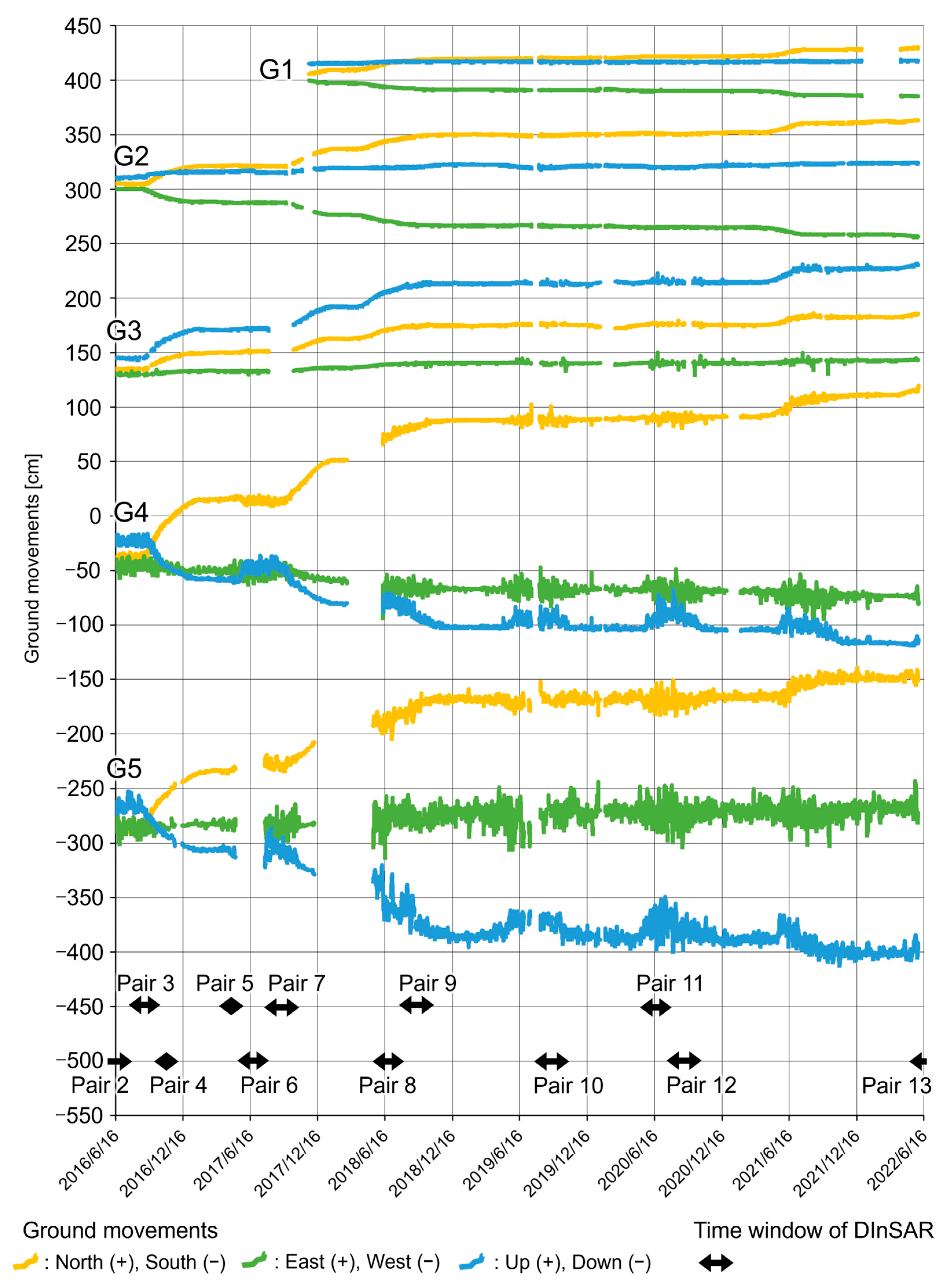
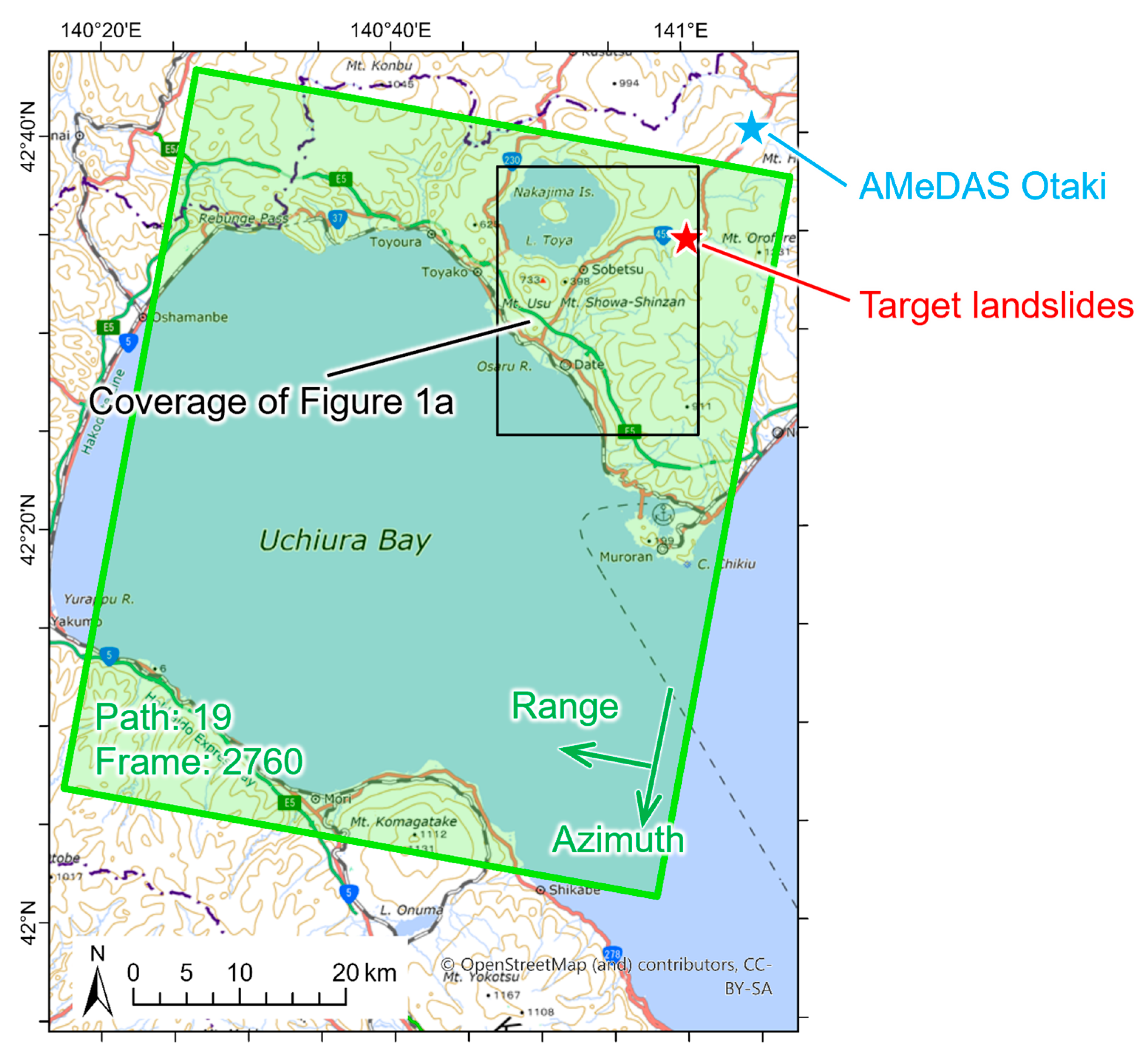
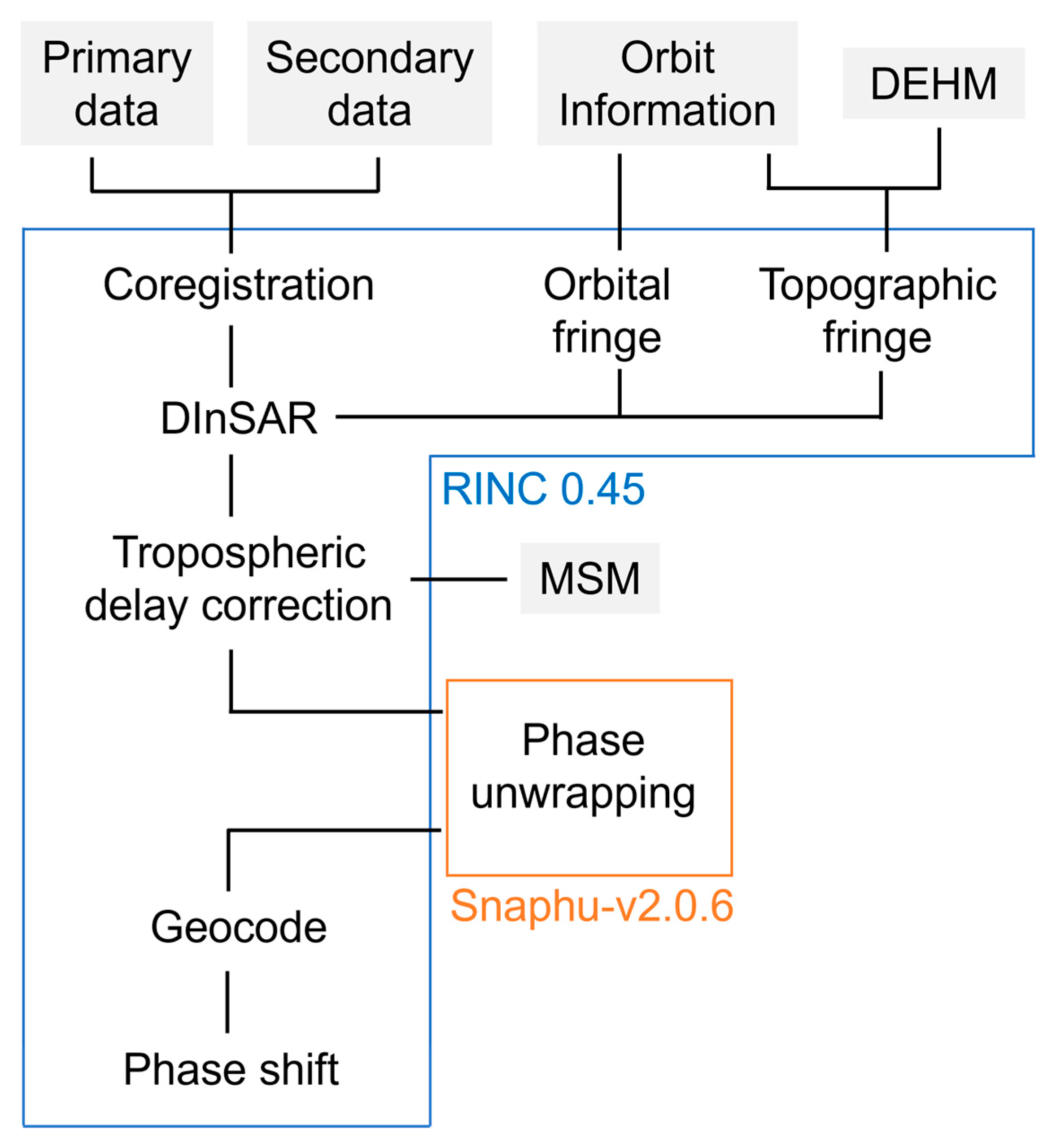

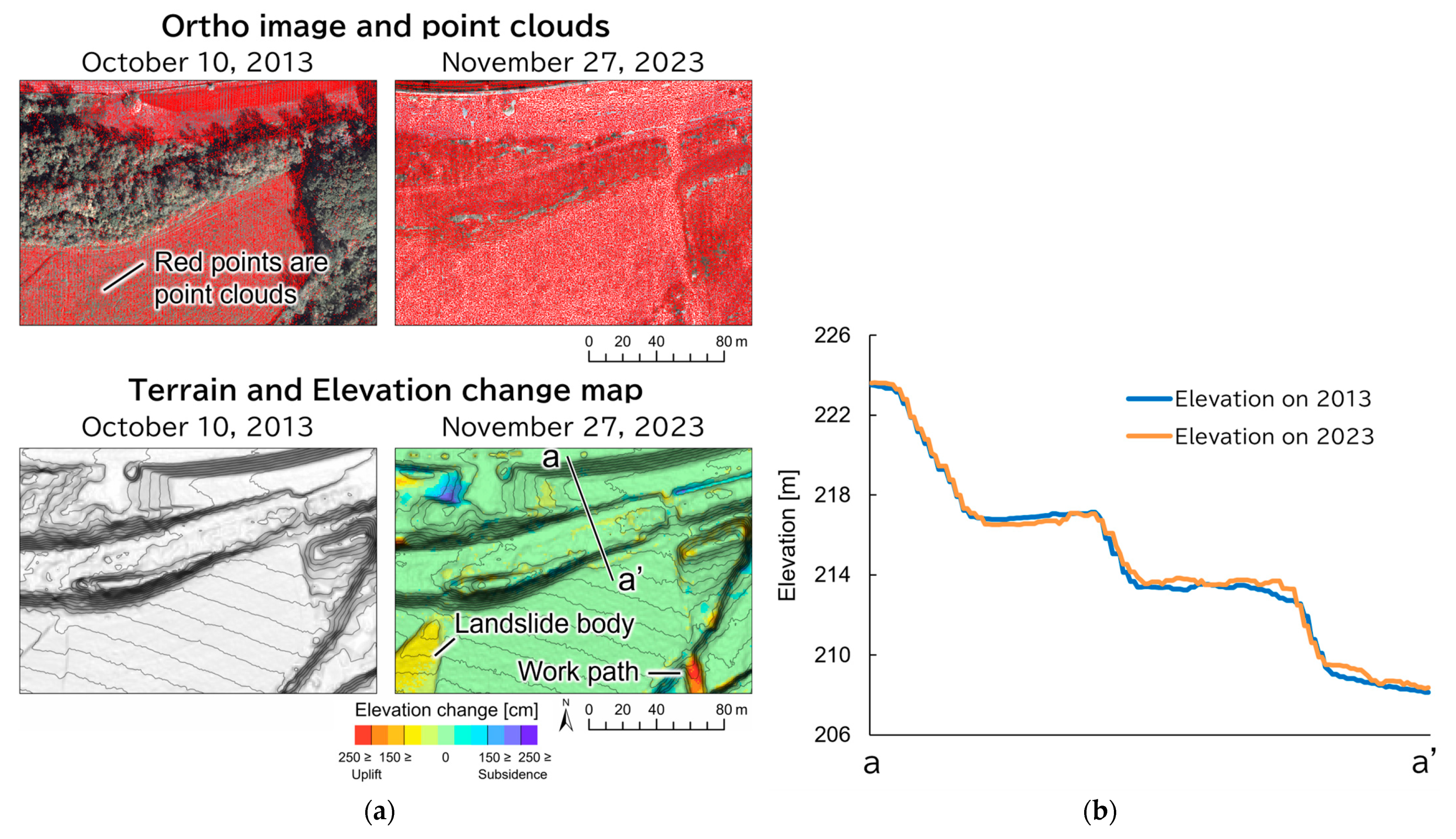



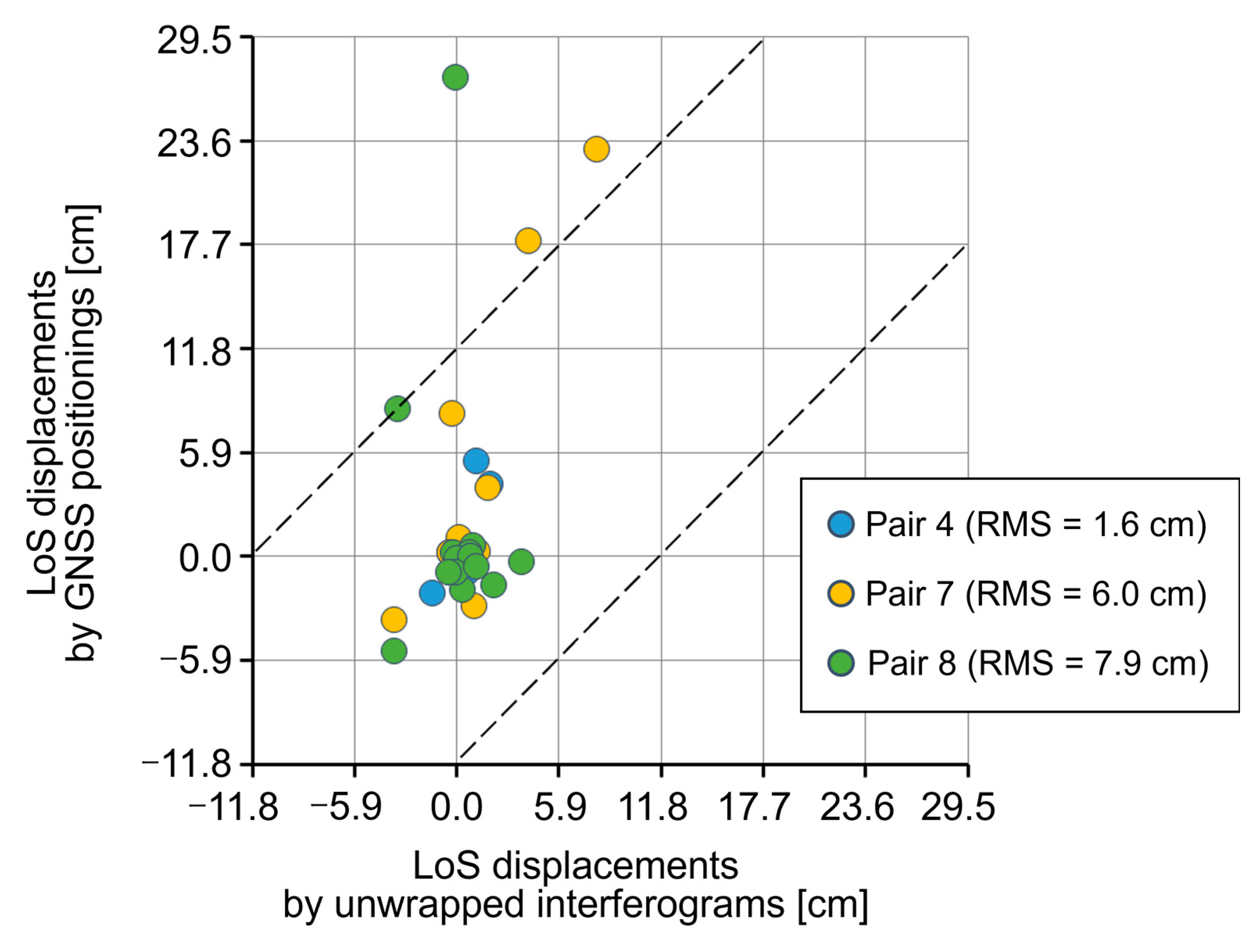

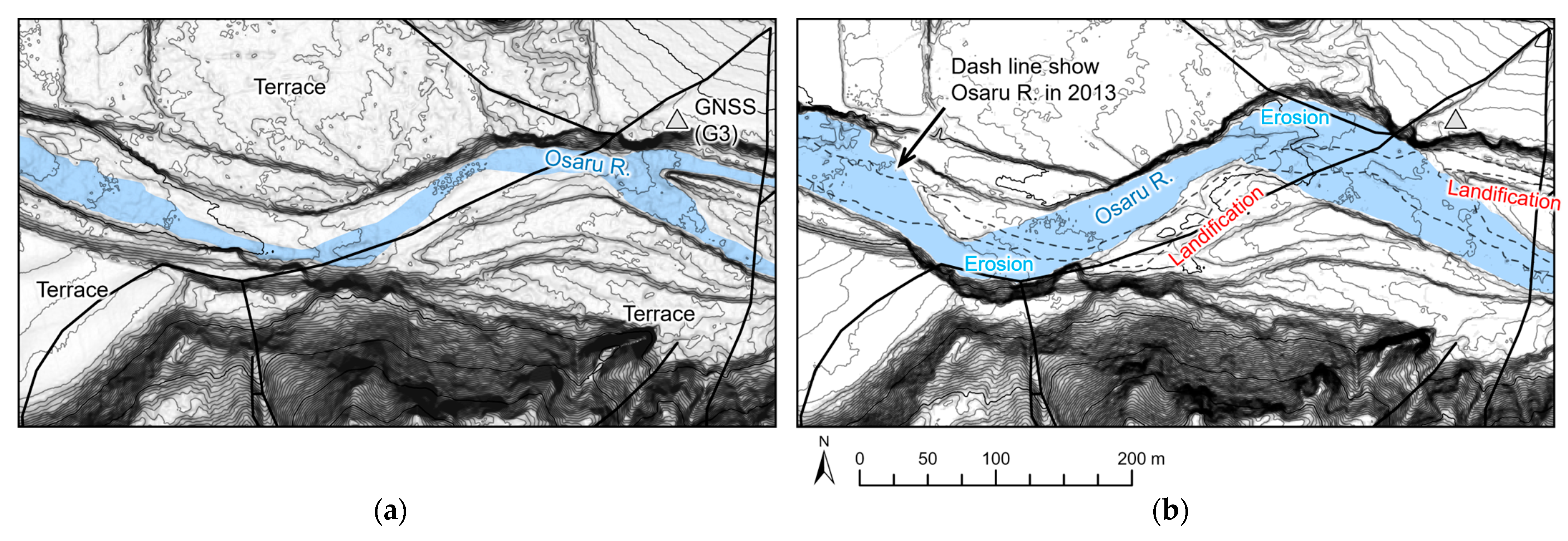
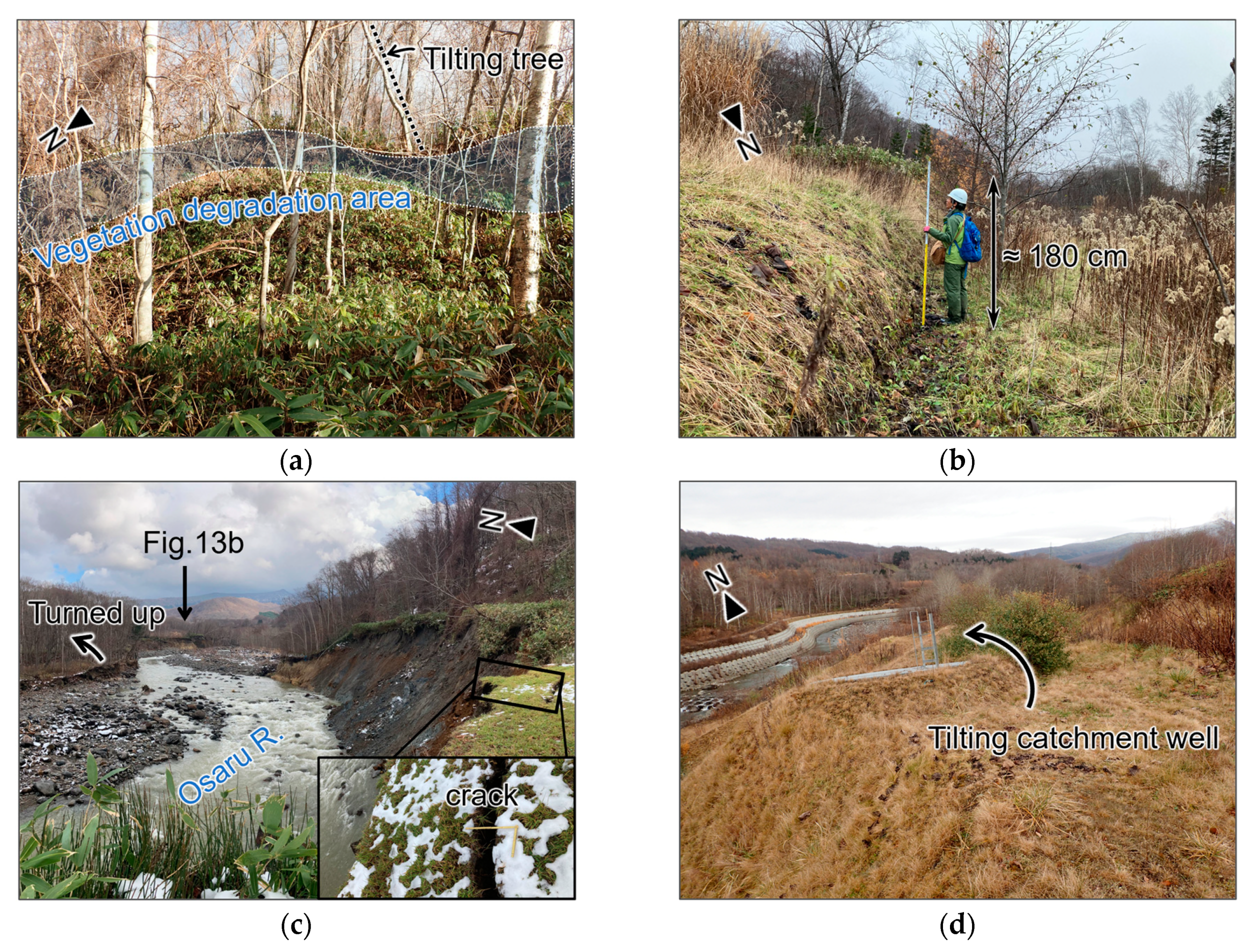
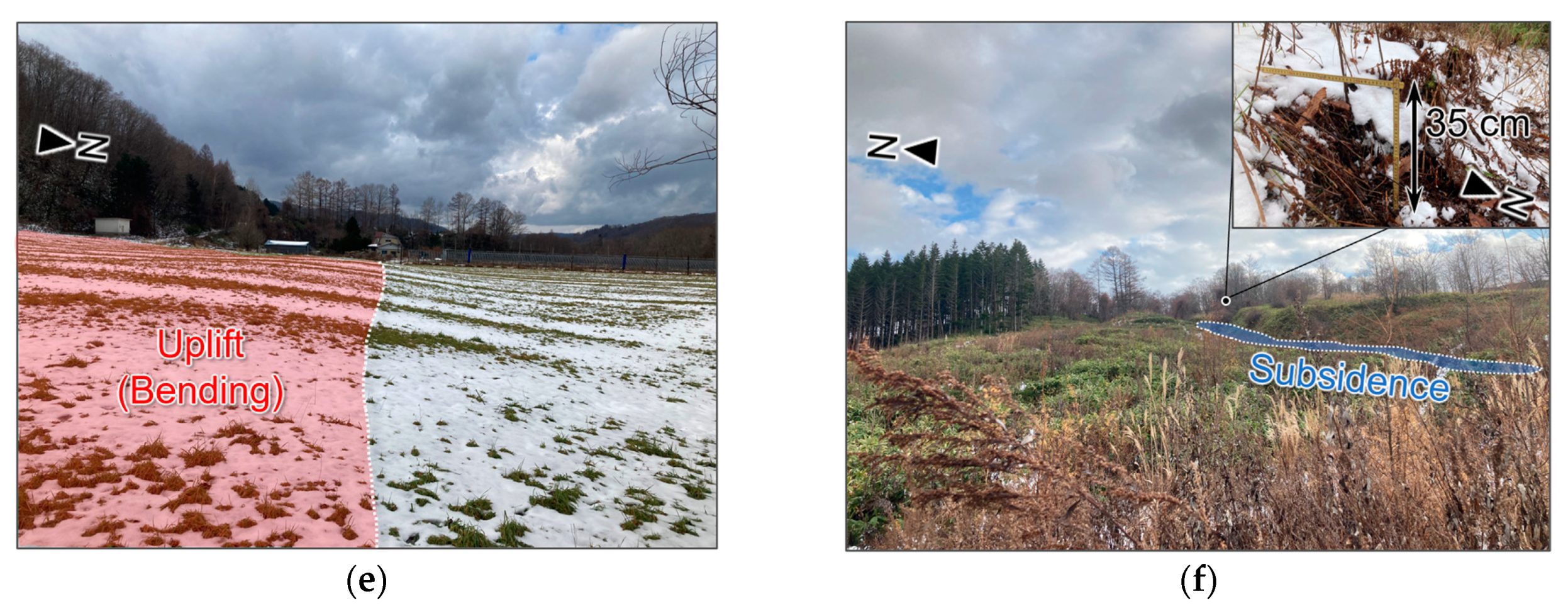

| Pair No. | Primary Date | Secondary Date | Time Window (Days) | Primary Weather 1 | Secondary Weather 1 |
|---|---|---|---|---|---|
| 1 | 1 September 2015 | 10 November 2015 | 70 | 0.5 h | 0.5 mm |
| 2 | 24 May 2016 | 2 August 2016 | 70 | 1.0 h | 0.6 h |
| 3 | 2 August 2016 | 11 October 2016 | 70 | 0.6 h | 1.0 h |
| 4 | 11 October 2016 | 25 October 2016 | 14 | 1.0 h | 1.0 h |
| 5 | 11 April 2017 | 23 May 2017 | 42 | 0.6 h | 1.0 h |
| 6 | 23 May 2017 | 1 August 2017 | 70 | 1.0 h | 0.6 h |
| 7 | 1 August 2017 | 24 October 2017 | 84 | 0.6 h | 0.7 h |
| 8 | 22 May 2018 | 31 July 2018 | 70 | 1.0 h | 1.0 h |
| 9 | 31 July 2018 | 23 October 2018 | 84 | 1.0 h | 1.0 h |
| 10 | 30 July 2019 | 22 October 2019 | 84 | 0.1 h | 0.7 h |
| 11 | 19 May 2020 | 28 July 2020 | 70 | 1.0 h | 0.5 mm |
| 12 | 28 September 2020 | 20 October 2020 | 84 | 0.5 mm | No data 2 |
| 13 | 17 May 2022 | 26 September 2022 | 70 | 1.0 h | 0.8 h |
| G1 | G2 | G3 | G4 | G5 | ||||||
|---|---|---|---|---|---|---|---|---|---|---|
| Pair No. | GNSS | DInSAR | GNSS | DInSAR | GNSS | DInSAR | GNSS | DInSAR | GNSS | DInSAR |
| 4 | No data | −0.1 1 | −0.9 | 0.6 | −2.1 | −1.4 | 4.1 | 1.9 | 5.4 | 1.1 |
| 7 | No data | −0.3 | −2.8 | 1.0 | −3.6 | −3.6 | 17.9 | 4.1 | 23.1 | 8.1 |
| 8 | −1.6 | 2.1 | −1.9 | 0.3 | −5.4 | −3.6 | 8.4 | −3.4 | 27.2 | −0.1 |
Disclaimer/Publisher’s Note: The statements, opinions and data contained in all publications are solely those of the individual author(s) and contributor(s) and not of MDPI and/or the editor(s). MDPI and/or the editor(s) disclaim responsibility for any injury to people or property resulting from any ideas, methods, instructions or products referred to in the content. |
© 2024 by the authors. Licensee MDPI, Basel, Switzerland. This article is an open access article distributed under the terms and conditions of the Creative Commons Attribution (CC BY) license (https://creativecommons.org/licenses/by/4.0/).
Share and Cite
Usami, S.; Ishimaru, S.; Tadono, T. Advantages of High-Temporal L-Band SAR Observations for Estimating Active Landslide Dynamics: A Case Study of the Kounai Landslide in Sobetsu Town, Hokkaido, Japan. Remote Sens. 2024, 16, 2687. https://doi.org/10.3390/rs16152687
Usami S, Ishimaru S, Tadono T. Advantages of High-Temporal L-Band SAR Observations for Estimating Active Landslide Dynamics: A Case Study of the Kounai Landslide in Sobetsu Town, Hokkaido, Japan. Remote Sensing. 2024; 16(15):2687. https://doi.org/10.3390/rs16152687
Chicago/Turabian StyleUsami, Seiya, Satoshi Ishimaru, and Takeo Tadono. 2024. "Advantages of High-Temporal L-Band SAR Observations for Estimating Active Landslide Dynamics: A Case Study of the Kounai Landslide in Sobetsu Town, Hokkaido, Japan" Remote Sensing 16, no. 15: 2687. https://doi.org/10.3390/rs16152687






